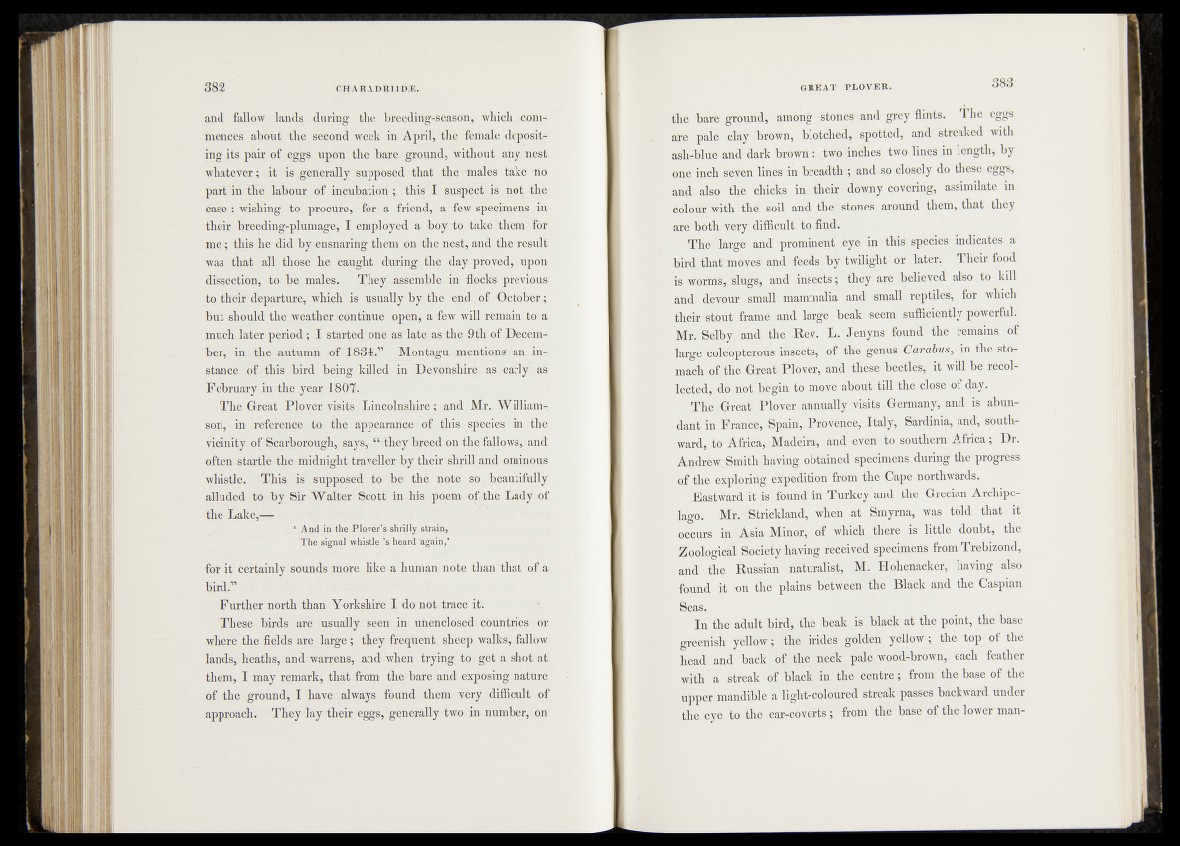
and fallow lands during the breeding-season, which commences
about the second week in April, the female depositing
its pair of eggs upon the bare ground, without any nest,
whatever; it is generally supposed that the -males take no
part in the labour of incubation; this I suspect is not-4he.
case : wishing to procure, for a friend, a few specimens in
their breeding-plumage, I employed a boy. to take them for
m e ; this he did by ensnaring them on the nest, and the result
was that all those he caught during the day proved, upon
dissection, to be males. They assemble in flocks previous,
to their departure, which is usually by the end Tof-^October;
but should the weather continue, open, a few will remain-to a
much later period; I started one as late as th eü th of d^ecem-.
her, in the autumn of -1834.” Montagu -mentions^an ■ instance
of this bird being killed in Devonshire as early as
February in the year 1807. |
The Great Plover visits Lincolnshire; and Mr. Williamson,
in reference to the Appeararice'-óf* th is. species in the.
vicinity of Scarborough, says, “ they breed, on the fallows,>'>*'and
often startle the midnight traveller by their shrill and omi&ous
whistle. This, is supposed to Aé the note so, beautifully
alluded to-by Sir Walter Scott in his poem of. the Lady of
the Lake,-—
‘ And in the Plover’s shrilly-siieia, t-
The signal whistle’s heard again,’
for it certainly sounds more like a human note tharrthat of a-,
bird.”
Further north than Yorkshire I do nofotrace it.
These birds are usually: seen in unénclosed'countries or
where the fields are large ; they, frequent- sheep walks, fallow
lands,.heaths, and warrens, and when trying tó get a shot; at >.
them, I may remark, that from the bare and'exposing nature
of the ground, I have always found them very, difficult of
approach. They lay their-eggs,'generally two in number, on'
the bare ground, among stones and grey flints. The eggs
are pale clay brown, blotched, spotted, and streaked with
ash-blue and dark brown : stwo inches two lines in length, by
one inch seven lines in breadth ; and so closely do these eggs,
and also the chicks in their downy covering, assimilate in
colour with the1 soil and the stones around them, that they
are both very difficult to find.
' The large and promiripBtf -„eye ;in this species indicates a
-bird thatmoves and feedif'hy twilight or later. Their food
is worms, .'Slugs, and insects-fCthe^Vare believed also to kill
and cteydur small' mammalia ;S|fd small reptile^,, for which
their,'sfeut frameand large beak seMr sufficiently powerful.,
Mr. f |H / a n d -the' Rev. L. Jeiiyns found the' remains of
?e o l^ t i i ( k s ^ S i i |s ; ' of the^enuS Carabus, in the sto-
l %ach of the GfeafJPlover, and^lhesblbeetles;- it will be recol-
*'le'Jed^db ,n o®M n to iipV%,abo4|till the:cloS|..of day.'
T h e -Great-PloM annually visits': Germany, and is .abundant
in F r a n * Spain, Provence; Italy, Sardinia, 'and, souths
ward, t|%frica,_Ma,defra;i 4 ^ ey em ^p |p th e rn Africa; Dr.
AndrevrSufth-kaving obtained specimens during the progress
of the “exploring e’^f^edi'^on'-froin- the Cape northwards.
Eastward it is||ound in Turkey and the 'Grecian Archipe- •
Klagq. Mr.' 'Strickland, when a t Smyrna, was told "that it
occurs in. Asia Minor, of which th'er,e little. doubt, the
Zoologic{lSo.cie1y having-freceived specimens from Trebizond,
and'* the " Russian naturalist, M. Hohenacker/ 1 having also
found it -on the plains between the Black and the Caspian
Seas.
In the adult bird, the beak 'is black at the point, the base
'v greenish yellpwf;^ ih6:ri|ddes goMen *yellow; the top of the
-head ^nd back of thrhieck pale wood-^wn, each feather
with a streak W ’black' in the" centr®from the base of the
upper mandibleIrlight-cofoflrbd ftrtlkvpasses backward under
t h e ^ A o the ear-cov6rts’V from the 'base of the lowbr man